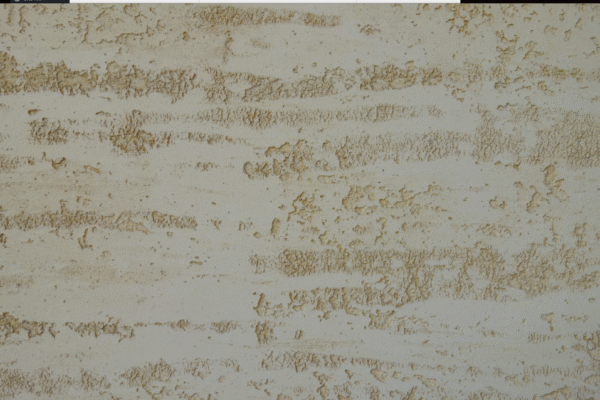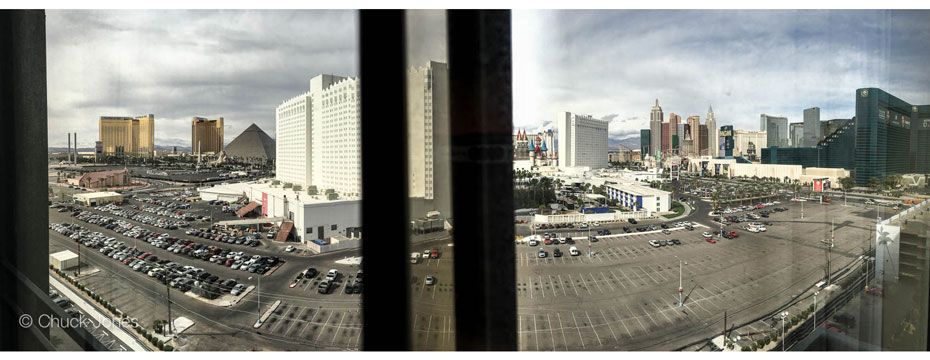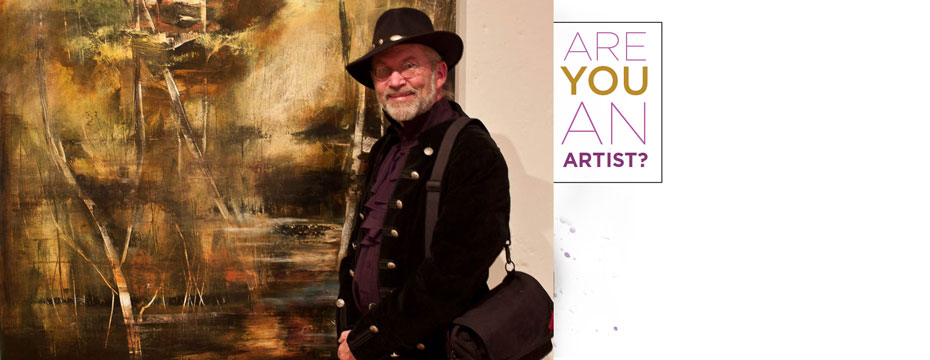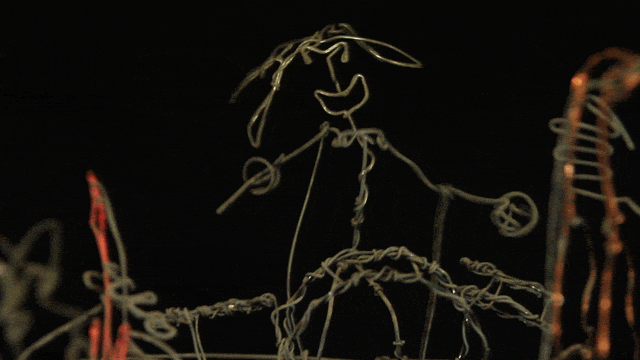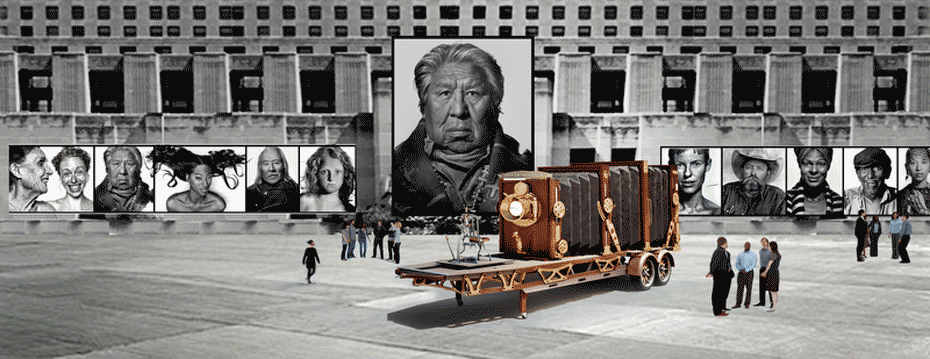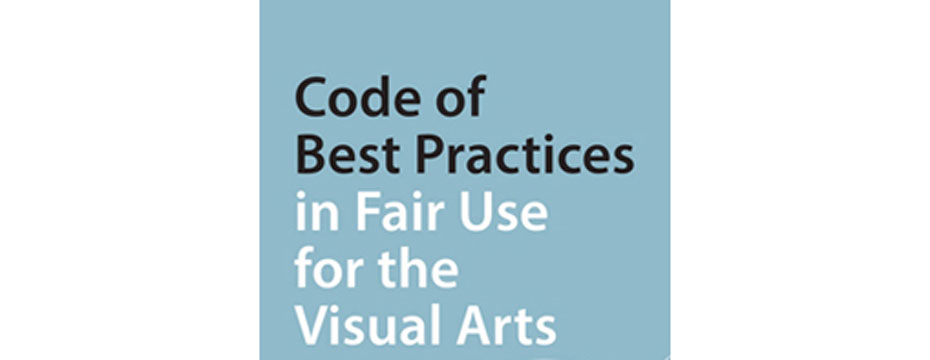
A Code of Best Practices in Fair Use for The Visual Arts
FAIR USE AND ONLINE VIDEO
Contrary to popular belief, United States Copyright and Patent Laws were not put into place to protect creators; they were an attempt to legislate creators to share some rights in their creations with others. The cultural value of copying is so well established that the United States Congress has written it into the social bargain at the heart of copyright law. This is the bargain: we as the United States society give limited property rights to creators, to reward them for producing culture; while at the same time, we give other artists and creators the chance to use that same copyrighted material, without permission or payment, in some circumstances and with some limitations or strings attached. Without the second half of the bargain, the “Consideration for the Public” we could all lose important new cultural work just because one particular person or corporation is arbitrary or greedy.
Cinemagraphs are a great example of fair use expanding and transforming art, as in this Kia automobile commercial Cinematographically Remixed above. ©2015, Chuck Jones
That @Kia Soul EV #Looks #good #driving a #cinemagraph @Flixel https://t.co/zc2s8wh6Td
— Chuck Jones (@chuckpjones) March 13, 2015
My Cinemagraph Tweet above immediately drew a Twitter post favorite from a not so desirable favorite from @FatalAuto, thus completing a full circle of “fair uses” for different purposes.
Twitter’s best place for recent news about fatal auto accidents. Drive safe and #sober!!!
What I and so many others of us as creators needed was a guide to understand what “Fair Use” was. And of equal importance, what Fair Use was not. What follows is the extensive work done by a great team I discovered from my research, and what I have adopted and use as a guide to fair use myself in my own work. This American University work is exactly on point for every photographer, videographer, content creator, graphic artist, and Hybrid Storyteller reading these words.
CODE OF BEST PRACTICES IN FAIR USE FOR ONLINE VIDEO
June 2008
Click here to view or download a PDF of this report.
Report by:
The Program on Information Justice and Intellectual Property,
American University Washington College of LawThe Center for Media & Social Impact,
American University
With funding from:
The Ford Foundation,
by way of the Future of Public Media Project
TABLE OF CONTENTS
Introduction
Background
Best Practices
1. Commenting on or critiquing of copyrighted material
2. Using copyrighted material for illustration or example
3. Capturing copyrighted material incidentally or accidentally
4. Reproducing, reposting, or quoting in order to memorialize, preserve, or rescue an experience, an event, or a cultural phenomenon
5. Copying, restoring, and recirculating a work or part of a work for purposes of launching a discussion
6. Quoting in order to recombine elements to make a new work that depends for its meaning on (often unlikely) relationships between the elements
Conclusion
Notes
Common Fair Use Myths
INTRODUCTION
What This Is
This document is a code of best practices that helps creators, online providers, copyright holders, and others interested in the making of online video interpret the copyright doctrine of fair use. Fair use is the right to use copyrighted material without permission or payment under some circumstances.
This is a guide to current acceptable practices, drawing on the actual activities of creators, as discussed among other places in the study Recut, Reframe, Recycle: Quoting Copyrighted Material in User-Generated Video and backed by the judgment of a national panel of experts. It also draws, by way of analogy, upon the professional judgment and experience of documentary filmmakers, whose own code of best practices has been recognized throughout the film and television businesses.
What This Isn’t
This code of best practices does not tell you the limits of fair use rights.
It’s not a guide to using material people give permission to use, such as works using Creative Commons licenses. Anyone can use those works the way the owners say that you can.
It’s not a guide to material that is already free to use without considering copyright. For instance, all federal government works are in the public domain, as are many older works. In most cases, trademarks are not an issue. For more information on “free use,” consult the document “Yes, You Can!” and copyright.cornell.edu.
It’s not a guide to using material that someone wants to license but cannot trace back to an owner–the so-called “orphan works” problem. However, orphan works are also eligible for fair use consideration, according to the principles detailed below.
How This Document Was Created
A distinguished panel of experts, drawn from cultural scholarship, legal scholarship, and legal practice, developed this code of best practices, informed by research into current personal and nonprofessional video practices (“user-generated video”) and on fair use. Full identification of panelists is on the back cover of this document.
BACKGROUND
Video is increasingly becoming a central part of our everyday landscape of communication, and it is becoming more visible as people share it on digital platforms. People make and share videos to tell stories about their personal lives, remixing home videos with popular music and images. Video remix has become a core component of political discourse, as the video “George Bush Don’t Like Black People” and the “Yes We Can” parodies demonstrated. Both amateur and professional editors are creating new forms of viral popular culture, as the “Dramatic Chipmunk” meme and the “Brokeback to the Future” mashup illustrate. The circulation of these videos is an emerging part of the business landscape, as the sale of YouTube to Google demonstrated.
More and more, video creation and sharing depend on the ability to use and circulate existing copyrighted work. Until now, that fact has been almost irrelevant in business and law, because broad distribution of nonprofessional video was relatively rare. Often people circulated their work within a small group of family and friends. But digital platforms make work far more public than it has ever been, and cultural habits and business models are developing. As practices spread and financial stakes are raised, the legal status of inserting copyrighted work into new work will become important for everyone.
It is important for video makers, online service providers, and content providers to understand the legal rights of makers of new culture, as policies and practices evolve. Only then will efforts to fight copyright “piracy” in the online environment be able to make necessary space for lawful, value-added uses.
Mashups, remixes, subs, and online parodies are new and refreshing online phenomena, but they partake of an ancient tradition: the recycling of old culture to make new. In spite of our romantic cliches about the anguished lone creator, the entire history of cultural production from Aeschylus through Shakespeare to Clueless has shown that all creators stand, as Isaac Newton (and so many others) put it, “on the shoulders of giants.”
In fact, the cultural value of copying is so well established that it is written into the social bargain at the heart of copyright law. The bargain is this: we as a society give limited property rights to creators, to reward them for producing culture; at the same time, we give other creators the chance to use that same copyrighted material without permission or payment, in some circumstances. Without the second half of the bargain, we could all lose important new cultural work just because one person is arbitrary or greedy.
Copyright law has several features that permit quotations from copyrighted works without permission or payment, under certain conditions. Fair use is the most important of these features. It has been an important part of copyright law for more than 150 years. Where it applies, fair use is a right, not a mere privilege. In fact, as the Supreme Court has pointed out, fair use keeps copyright from violating the First Amendment. As copyright protects more works for longer periods than ever before, it makes new creation harder. As a result, fair use is more important today than ever before.
Copyright law does not exactly specify how to apply fair use, and that is to creators’ advantage. Creative needs and practices differ with the field, with technology, and with time. Rather than following a specific formula, lawyers and judges decide whether an unlicensed use of copyrighted material is “fair” according to a “rule of reason.” This means taking all the facts and circumstances into account to decide if an unlicensed use of copyright material generates social or cultural benefits that are greater than the costs it imposes on the copyright owner.
Fair use is flexible; it is not uncertain or unreliable. In fact, for any particular field of critical or creative activity, lawyers and judges consider expectations and practice in assessing what is “fair” within the field. In weighing the balance at the heart of fair use analysis, judges refer to four types of considerations mentioned in the law: the nature of the use, the nature of the work used, the extent of the use and its economic effect. This still leaves much room for interpretation, especially since the law is clear that these are not the only necessary considerations. In reviewing the history of fair use litigation, we find that judges return again and again to two key questions:
• Did the unlicensed use “transform” the material taken from the copyrighted work by using it for a different purpose than that of the original, or did it just repeat the work for the same intent and value as the original?
• Was the material taken appropriate in kind and amount, considering the nature of the copyrighted work and of the use?
Both questions touch on, among other things, the question of whether the use will cause excessive economic harm to the copyright owner.
If the answers to these two questions are “yes,” a court is likely to find a use fair. Because that is true, such a use is unlikely to be challenged in the first place.
Another consideration underlies and influences the way in which these questions are analyzed: whether the user acted reasonably and in good faith, in light of general practice in his or her particular field. Online video makers’ ability to rely on fair use will be enhanced by the Code of Best Practices in Fair Use that follows. This code of best practices serves as evidence of commonly held understandings–some drawn from the experience of other creative communities (including documentary filmmakers) and supported by legal precedents, and all grounded in current practice of online video. Thus, the code helps to demonstrate the reasonableness of uses that fall within its principles.
Video makers can take heart from other creator groups’ reliance on fair use. For instance, historians regularly quote both other historians’ writings and textual sources; filmmakers and visual artists reinterpret and critique existing work; scholars illustrate cultural commentary with textual, visual, and musical examples. Equally important is the example of commercial news media. Fair use is healthy and vigorous in daily broadcast television news, where references to popular films, classic TV programs, archival images, and popular songs are constant and routinely unlicensed.
Unlike many traditional creator groups, nonprofessional and personal video makers often create and circulate their videos outside the marketplace. Such works, especially if they are circulated within a delimited network, do enjoy certain copyright advantages. Not only are they less likely to attract the attention of rights holders, but if noticed they are more likely to receive special consideration under the fair use doctrine. That said, our goal here is to define the widely accepted contours of fair use that apply with equal force across a range of commercial and noncommercial activities, without regard to how video maker communities’ markets may evolve. Thus, the principles articulated below are rooted squarely in the concept of “transformativeness.”
In fact, a transformative purpose often underlies an individual creator’s investment of substantial time and creative energy in producing a mashup, a personal video, or other new work. Images and sounds can be building blocks for new meaning, just as quotations of written texts can be. Emerging cultural expression deserves recognition for transformative value as much as more established expression.
BEST PRACTICES
This code of practices is organized, for ease of understanding, around common situations that come up for online video makers. These situations do not, of course, exhaust the possible applications of fair use to tomorrow’s media-making techniques.
But first, one general comment: Inevitably, considerations of good faith come into play in fair use analysis. One way to show good faith is to provide credit or attribution, where possible, to the owners of the material being used.
ONE: Commenting on or critiquing of copyrighted material
Video makers often take as their raw material an example of popular culture, which they comment on in some way. They may add unlikely subtitles. They may create a fan tribute (positive commentary) or ridicule a cultural object (negative commentary). They may comment or criticize indirectly (by way of parody, for example), as well as directly. They may solicit critique by others, who provide the commentary or add to it.
PRINCIPLE: Video makers have the right to use as much of the original work as they need to in order to put it under some kind of scrutiny. Comment and critique are at the very core of the fair use doctrine as a safeguard for freedom of expression. So long as the maker analyzes, comments on, or responds to the work itself, the means may vary. Commentary may be explicit (as might be achieved, for example, by the addition of narration) or implicit (accomplished by means of recasting or recontextualizing the original). In the case of negative commentary, the fact that the critique itself may do economic damage to the market for the quoted work (as a negative review or a scathing piece of ridicule might) is irrelevant.
LIMITATION: The use should not be so extensive or pervasive that it ceases to function as critique and becomes, instead, a way of satisfying the audience’s taste for the thing (or the kind of thing) that is being quoted. In other words, the new use should not become a market substitute for the work (or other works like it).
TWO: Using copyrighted material for illustration or example
Sometimes video makers quote copyrighted material (for instance, music, video, photographs, animation, text) not in order to comment upon it, but because it aptly illustrates an argument or a point. For example, clips from Hollywood films might be used to demonstrate changing American attitudes toward race; a succession of photos of the same celebrity may represent the stages in the star’s career; a news clip of a politician speaking may reinforce an assertion.
PRINCIPLE: This sort of quotation generally should be considered fair use and is widely recognized as such in other creative communities. For instance, writers in print media do not hesitate to use illustrative quotations of both words and images. The possibility that the quotes might entertain and engage an audience as well as illustrate a video maker’s argument takes nothing away from the fair use claim. Works of popular culture typically have illustrative power precisely because they are popular. This kind of use is fair when it is important to the larger purpose of the work but also subordinate to it. It is fair when video makers are not presenting the quoted material for its original purpose but to harness it for a new one. This kind of use is, thus, creating new value.
LIMITATIONS: To the extent possible and appropriate, illustrative quotations should be drawn from a range of different sources; and each quotation (however many may be employed to create an overall pattern of illustrations) should be no longer than is necessary to achieve the intended effect. Properly attributing material, whether in the body of the text, in credits, or in associated material will often reduce the likelihood of complaints or legal action and may bolster a maker’s fair use claim.
THREE: Capturing copyrighted material incidentally or accidentally
Video makers often record copyrighted sounds and images when they are recording sequences in everyday settings. For instance, they may be filming a wedding dance where copyrighted music is playing, capturing the sight of a child learning to walk with a favorite tune playing in the background, or recording their own thoughts in a bedroom with copyrighted posters on the walls. Such copyrighted material is an audio-visual found object. In order to eliminate this incidentally or accidentally captured material, makers would have to avoid, alter, or falsify reality.
PRINCIPLE: Fair use protects the creative choices of video makers who seek their material in real life. Where a sound or image has been captured incidentally and without pre-arrangement, as part of an unstaged scene, it is permissible to use it, to a reasonable extent, as part of the final version of the video. Otherwise, one of the fundamental purposes of copyright–to encourage new creativity–would be betrayed.
LIMITATION: In order to take advantage of fair use in this context, the video maker should be sure that the particular media content played or displayed was not requested or directed; that the material is integral to the scene or its action; that the use is not so extensive that it calls attention to itself as the primary focus of interest; and that where possible, the material used is properly attributed.
FOUR: Reproducing, reposting, or quoting in order to memorialize, preserve, or rescue an experience, an event, or a cultural phenomenon
Repurposed copyrighted material is central to this kind of video. For instance, someone may record their favorite performance or document their own presence at a rock concert. Someone may post a controversial or notorious moment from broadcast television or a public event (a Stephen Colbert speech, a presidential address, a celebrity blooper). Someone may reproduce portions of a work that has been taken out of circulation, unjustly in their opinion. Gamers may record their performances.
PRINCIPLE: Video makers are using new technology to accomplish culturally positive functions that are widely accepted–or even celebrated–in the analog information environment. In other media and platforms, creators regularly recollect, describe, catalog, and preserve cultural expression for public memory. Written memoirs for instance are valued for the specificity and accuracy of their recollections; collectors of ephemeral material are valued for creating archives for future users. Such memorializing transforms the original in various ways–perhaps by putting the original work in a different context, perhaps by putting it in juxtaposition with other such works, perhaps by preserving it. This use also does not impair the legitimate market for the original work.
LIMITATION: Fair use reaches its limits when the entertainment content is reproduced in amounts that are disproportionate to purposes of documentation, or in the case of archiving, when the material is readily available from authorized sources.
FIVE: Copying, restoring, and recirculating a work or part of a work for purposes of launching a discussion
Online video contributors often copy and post a work or part of it because they love or hate it, or find it exemplary of something they love or hate, or see it as the center of an existing debate. They want to share that work or portion of a work because they have a connection to it and want to spur a discussion about it based on that connection. These works can be, among other things, cultural (Worst Music Video Ever!, a controversial comedian’s performance), political (a campaign appearance or ad), social or educational (a public service announcement, a presentation on a school’s drug policy).
PRINCIPLE: Such uses are at the heart of freedom of expression and demonstrate the importance of fair use to maintain this freedom. When content that originally was offered to entertain or inform or instruct is offered up with the distinct purpose of launching an online conversation, its use has been transformed. When protected works are selectively repurposed in this way, a fundamental goal of the copyright system–to promote the republican ideal of robust social discourse–is served.
LIMITATIONS: The purpose of the copying and posting needs to be clear; the viewer needs to know that the intent of the poster is to spur discussion. The mere fact that a site permits comments is not enough to indicate intent. The poster might title a work appropriately so that it encourages comment, or provide context or a spur to discussion with an initial comment on a site, or seek out a site that encourages commentary.
SIX: Quoting in order to recombine elements to make a new work that depends for its meaning on (often unlikely) relationships between the elements
Video makers often create new works entirely out of existing ones, just as in the past artists have made collages and pastiches. Sometimes there is a critical purpose, sometimes a celebratory one, sometimes a humorous or other motive, in which new makers may easily see their uses as fair under category one. Sometimes, however, juxtaposition creates new meaning in other ways. Mashups (the combining of different materials to compose a new work), remixes (the re-editing of an existing work), and music videos all use this technique of recombining existing material. Other makers achieve similar effects by adding their own new expression (subtitles, images, dialog, sound effects or animation, for example) to existing works.
PRINCIPLE: This kind of activity is covered by fair use to the extent that the reuse of copyrighted works creates new meaning by juxtaposition. Combining the speeches by two politicians and a love song, for example, as in “Bush Blair Endless Love,” changes the meaning of all three pieces of copyrighted material. Combining the image of an innocent prairie dog and three ominous chords from a movie soundtrack, as in “Dramatic Chipmunk,” creates an ironic third meaning out of the original materials. The recombinant new work has a cultural identity of its own and addresses an audience different from those for which its components were intended.
LIMITATIONS: If a work is merely reused without significant change of context or meaning, then its reuse goes beyond the limits of fair use. Similarly, where the juxtaposition is a pretext to exploit the popularity or appeal of the copyrighted work employed, or where the amount of material used is excessive, fair use should not apply. For example, fair use will not apply when a copyrighted song is used in its entirety as a sound track for a newly created video simply because the music evokes a desired mood rather than to change its meaning; when someone sings or dances to recorded popular music without comment, thus using it for its original purpose; or when newlyweds decorate or embellish a wedding video with favorite songs simply because they like those songs or think they express the emotion of the moment.
CONCLUSION
These principles don’t exhaust the possibilities of fair use for online video. They merely address the most common situations today. Inevitably, online video makers will find themselves in situations that are hybrids of those described above or will develop new practices. Then, they can be guided by the same basic values of fairness, proportionality, and reasonableness that inform this code of practices. As community practices develop and become more public, the norms that emerge from these practices will themselves provide additional information on what is fair use
NOTES
Authoring Organizations
The Program on Information Justice and Intellectual Property, led by Professor Peter Jaszi, promotes social justice in law governing information dissemination and intellectual property through research, scholarship, public events, advocacy, and provision of legal and consulting services. The program is a project of the Washington College of Law at American University in Washington, D.C., led by Dean Claudio Grossman.
The Center for Media & Social Impact, led by Professor Patricia Aufderheide, showcases and analyzes media for social justice, civil society, and democracy, and the public environment that nurtures them. The center is a project of the School of Communication, led by Dean Larry Kirkman, at American University in Washington, D.C.
Code of Best Practices Committee
CO-CHAIRS
Peter Jaszi,
Professor of Law, Faculty Director of the Glushko-Samuelson Intellectual Property Clinic, Washington College of Law, American University
Pat Aufderheide,
Professor, Co-Director of the Center for Media & Social Impact, School of Communication, American University
MEMBERS
Michael C. Donaldson, Esq.,
Los Angeles
Anthony Falzone,
Lecturer, Executive Director, Fair Use Project, Stanford Law School
Lewis Hyde,
Richard L. Thomas Professor of Creative Writing, Kenyon College; Fellow, Berkman Center for Internet and Society, Harvard University
Mizuko Ito,
Research Scientist, School of Cinematic Arts, University of Southern California
Henry Jenkins,
Professor, Program Head, Comparative Media Studies, Massachusetts Institute of Technology
Michael Madison,
Associate Dean for Research, Associate Professor of Law, University of Pittsburgh School of Law
Pamela Samuelson,
Richard M. Sherman Distinguished Professor of Law and Information, University of California, Berkeley
Rebecca Tushnet,
Professor, Georgetown University Law Center, Georgetown University
Jennifer Urban,
Clinical Associate Professor of Law, Director of the Intellectual Property and Technology Law Clinic, University of Southern California
Feel free to reproduce this work in its entirety. For excerpts and quotations, depend upon fair use.
Reproduced here with additions and with permission as above from: CMSI
Please rate this story, and share it with your friends? [ratings]



 Fatal Auto
Fatal Auto 